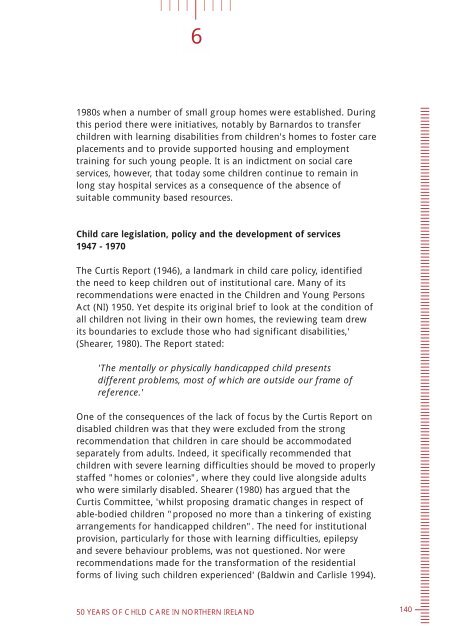childcare-50years
childcare-50years
childcare-50years
Create successful ePaper yourself
Turn your PDF publications into a flip-book with our unique Google optimized e-Paper software.
6<br />
1980s when a number of small group homes were established. During<br />
this period there were initiatives, notably by Barnardos to transfer<br />
children with learning disabilities from children's homes to foster care<br />
placements and to provide supported housing and employment<br />
training for such young people. It is an indictment on social care<br />
services, however, that today some children continue to remain in<br />
long stay hospital services as a consequence of the absence of<br />
suitable community based resources.<br />
Child care legislation, policy and the development of services<br />
1947 - 1970<br />
The Curtis Report (1946), a landmark in child care policy, identified<br />
the need to keep children out of institutional care. Many of its<br />
recommendations were enacted in the Children and Young Persons<br />
Act (NI) 1950. Yet despite its original brief to look at the condition of<br />
all children not living in their own homes, the reviewing team drew<br />
its boundaries to exclude those who had significant disabilities,'<br />
(Shearer, 1980). The Report stated:<br />
'The mentally or physically handicapped child presents<br />
different problems, most of which are outside our frame of<br />
reference.'<br />
One of the consequences of the lack of focus by the Curtis Report on<br />
disabled children was that they were excluded from the strong<br />
recommendation that children in care should be accommodated<br />
separately from adults. Indeed, it specifically recommended that<br />
children with severe learning difficulties should be moved to properly<br />
staffed "homes or colonies", where they could live alongside adults<br />
who were similarly disabled. Shearer (1980) has argued that the<br />
Curtis Committee, 'whilst proposing dramatic changes in respect of<br />
able-bodied children "proposed no more than a tinkering of existing<br />
arrangements for handicapped children". The need for institutional<br />
provision, particularly for those with learning difficulties, epilepsy<br />
and severe behaviour problems, was not questioned. Nor were<br />
recommendations made for the transformation of the residential<br />
forms of living such children experienced' (Baldwin and Carlisle 1994).<br />
50 YEARS OF CHILD CARE IN NORTHERN IRELAND<br />
140


